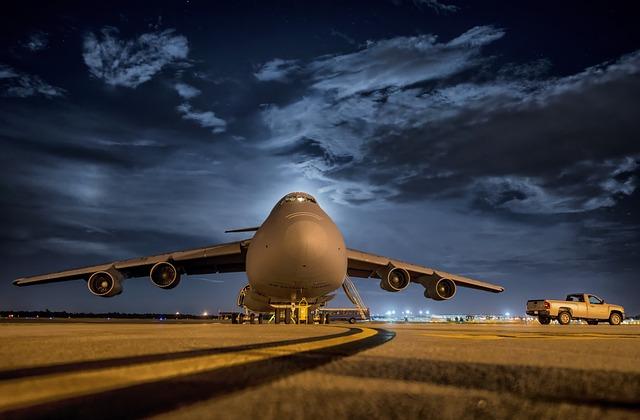In an important construction in U.S. army operations in Africa, the primary C-17 delivery airplane has departed from Niger as a part of a strategic drawdown through U.S. africa Command (AFRICOM). This withdrawal marks a pivotal second within the evolving dynamics of American army presence at the continent, reflecting adjustments in operational priorities and regional safety concerns. The C-17, identified for its skill to move heavy shipment and staff over lengthy distances, symbolizes now not simply the logistical features of U.S. forces but additionally the transferring center of attention of army engagement in West Africa amid expanding instability and the specter of terrorism. Because the U.S. re-evaluates its footprint within the area, this flight serves as a tangible reminder of the complexities interested in international army operations and the ongoing challenge of balancing nationwide safety pursuits with native realities.
First C-17 Withdrawal Flight Marks a New Bankruptcy for U.S. Operations in Niger
The new departure of the primary C-17 Globemaster III airplane from Niger indicates a pivotal second in U.S. army operations throughout West Africa. This withdrawal marks the start of a strategic transition because the U.S. reassesses its army presence and center of attention within the area. The C-17,identified for its exceptional means to move troops and provides,had performed a very important position in supporting missions all the way through the Sahel,contributing to each logistical operations and humanitarian efforts. Because the airplane ascended into the Nigerien sky, it carried now not simply shipment, however a way of exchange as regional dynamics evolve.
The verdict to withdraw this airplane is a part of a much wider technique that aligns with each operational potency and budgetary concerns. Key parts using this modification come with:
- Larger Regional Self-Sufficiency: Empowering native forces to take rate of safety operations.
- Center of attention on intelligence and surveillance: Transitioning sources to fortify oversight of rising threats.
- Partnership Strengthening: Construction more potent ties with allied international locations to foster steadiness within the area.
This shift signifies a broader figuring out of the complexities of safety in West Africa, the place terrorism and humanitarian problems call for a nuanced manner. Because the U.S. army continues to conform to those demanding situations, the results of this withdrawal will probably be carefully monitored through each allies and adversaries alike.

Strategic Implications of the C-17 Withdrawal for U.S. Africa Command
The withdrawal of the C-17 airplane from Niger indicates a pivotal shift in U.S.Africa Command’s operational panorama, elevating essential questions on logistical readiness and strategic posture within the area. With the C-17’s capacity to move massive shipment over lengthy distances, its go out would possibly impede the U.S. army’s skill to reply unexpectedly to rising threats, supply humanitarian help, and beef up regional companions successfully. This construction invitations a reevaluation of the air mobility features important for maintaining influence and executing missions around the huge and numerous African continent.
Additionally, the results lengthen past mere logistics. The united statesmust now imagine selection methods to maintain its engagements and partnerships in Africa.Key concerns come with:
- Strengthening Native Alliances: Improving relationships with regional air forces and logistical companions coudl mitigate the affect of the withdrawal.
- Adapting Challenge Profiles: Prioritizing missions that may leverage change modes of delivery or nearer staging bases would possibly assist deal with operational efficacy.
- Expanding use of Drones: Increasing using unmanned aerial automobiles may supplement the decreased airlift means.
| Facet | Problem | Possible Answers |
|---|---|---|
| Operational readiness | Lowered airlift means | Support regional partnerships |
| Strategic Affect | Restricted speedy deployment | Adapt venture profiles |
| Logistics | Items transportation | Build up drone operations |

Assessing the Humanitarian Have an effect on of Lowered U.S.Army Presence in Niger
The withdrawal of U.S.army staff from Niger marks an important shift within the area’s safety dynamics. Traditionally, the presence of U.S. forces has aimed to strengthen native army features and counteract extremist threats emanating from neighboring nations. Although, with the continued relief of this footprint, native communities would possibly face higher vulnerability to militant teams like Boko Haram, in addition to demanding situations associated with governance and public protection.Native NGOs and humanitarian organizations are particularly involved concerning the attainable ramifications for displaced populations, who rely on safety beef up to get entry to crucial products and services and help. It’s certainly the most important to evaluate the results of this withdrawal on regional steadiness and humanitarian get entry to within the months to return.
Within the aftermath of this transition, a number of key elements want to be monitored carefully. Those come with:
- Safety threats: Inspecting the upward thrust of militant job within the absence of U.S. forces.
- Humanitarian help get entry to: Comparing how decreased safety would possibly impede help supply to susceptible populations.
- Native governance: Watching the reaction of Nigerien government in keeping up order and public accept as true with.
An instantaneous research of those parts will assist tell long term global reaction efforts and help methods. The possibility of higher instability may necessitate a reevaluation of exterior beef up mechanisms and deployment of sources to be sure that humanitarian wishes are nonetheless met, in spite of the converting safety panorama.

Suggestions for Long term U.S. Engagement in West africa
Because the U.S. recalibrates its army presence in West Africa following the C-17 withdrawal from Niger, it’s certainly crucial to prioritize strategic engagement that addresses each regional steadiness and native construction wishes. Partnership with native governments must be enhanced to foster higher safety cooperation, with an emphasis on capacity-building tasks. This might come with:
- Joint coaching methods to strengthen the features of native safety forces.
- Intelligence-sharing agreements to fortify situational consciousness in preventing terrorism.
- Group engagement efforts to construct accept as true with between safety forces and native populations.
Moreover, U.S. coverage must undertake a multifaceted manner that now not handiest comprises army concerns but additionally diplomatic and financial avenues for engagement. This will also be successfully carried out via:
| Technique | Description |
|---|---|
| Financial Construction Projects | Put money into native infrastructure tasks to stimulate financial enlargement. |
| Diplomatic Dialogues | Interact in ongoing discussions with regional organizations like ECOWAS for collaborative safety frameworks. |
| Toughen for Governance | Advertise democratic governance and human rights via centered international help. |
By way of aligning army sources with broader diplomatic and financial methods, the U.S. can bolster steadiness in West Africa whilst fostering resilient partnerships that cope with each instant safety demanding situations and long-term developmental targets.

Native Reactions to the Departure: Group Views on Safety and Balance
as information broke concerning the first C-17 withdrawal flight from Niger, native communities expressed a mixture of considerations and anticipations in regards to the long term panorama of safety and steadiness within the area. Many citizens concern that the departure of U.S. forces would possibly go away a vacuum that might embolden extremist teams.The overall sentiment highlights a couple of key problems:
- Larger Vulnerability: Locals worry that the absence of American army presence would possibly cause them to extra vulnerable to assaults from militant teams working within the Sahel area.
- Financial Affects: The army’s presence fostered native industry enlargement; its departure would possibly disrupt this financial steadiness.
- Believe in Native Forces: There may be skepticism concerning the means of native troops to deal with order and safety with out exterior beef up.
Conversely, some neighborhood leaders view the departure as a chance for Nigerien forces to claim extra regulate and possession over their safety affairs. This outlook is mirrored in ongoing discussions amongst civic teams. One of the crucial prevailing ideas come with:
- empowerment of native Government: Advocates argue this may result in better responsibility and responsive governance.
- Geopolitical Realignment: The shift would possibly inspire partnerships with neighboring nations to deal with safety demanding situations collaboratively.
- Center of attention on Construction: A redirection of sources in opposition to financial construction tasks may assist construct long-term steadiness.

Taking a look Forward: The Long term of U.S. Army Logistics in Africa
The new withdrawal of the C-17 Globemaster III from Niger marks a pivotal second in U.S. army logistics inside of Africa. Because the U.S. seeks to recalibrate its army presence, the strategic center of attention is more likely to shift in opposition to improving regional partnerships and features. This transition underscores the significance of adaptability in logistical operations, which can turn into increasingly more reliant on native cooperation and the improvement of African international locations’ army infrastructure. Listed here are key concerns for the long run:
- Strengthening Partnerships: Collaborative logistics frameworks with African companions will probably be crucial for sustained operational luck.
- Emphasis on Era: Advances in drone and satellite tv for pc applied sciences will fortify provide chain efficiencies and scale back operational dangers.
- Coaching and Capability Construction: Making an investment in native forces and logistics coaching will result in extra self-sufficient and resilient army operations.
Taking a look forward, a strategic integration of logistics and protection tasks guarantees to redefine U.S. army engagement in Africa. Working out regional dynamics and logistics features will probably be the most important for long term missions. To verify a continuing transition, the usmilitary will want to center of attention on:
| Center of attention Spaces | Have an effect on on Logistics |
|---|---|
| Regional Safety Operations | complements coordination for sooner reaction instances. |
| Useful resource Allocation | optimizes logistics routes and minimizes waste. |
| Agile Provide Chains | Facilitates speedy deployment and flexibility to converting environments. |
to sum up
As the primary C-17 withdrawal flight departs from Niger, marking an important milestone in U.S. Africa Command’s strategic operations, the results of this transition lengthen past logistical concerns.This withdrawal indicates a shift in U.S. army posture within the area, because the command re-evaluates its strategy to counterterrorism and regional steadiness amidst evolving geopolitical dynamics.
The departure of those airplane underscores the continued demanding situations confronted through U.S.forces in Africa, together with the desire for adaptability in accordance with rising threats. As the placement develops, the focal point will stay on making sure the security and safety of the area whilst fostering partnerships with native forces to fight extremist teams.
Transferring ahead, it’ll be essential to observe the results of this withdrawal on each native safety environments and broader U.S. strategic pursuits in Africa.the narrative surrounding U.S. army involvement within the continent continues to spread, and the results of those tendencies will probably be felt for years yet to come.
Source link : https://afric.news/2025/02/23/first-c-17-withdrawal-flight-departs-from-niger-u-s-africa-command/
Creator : Atticus Reed
Post date : 2025-02-23 00:08:00
Copyright for syndicated content material belongs to the connected Source.



